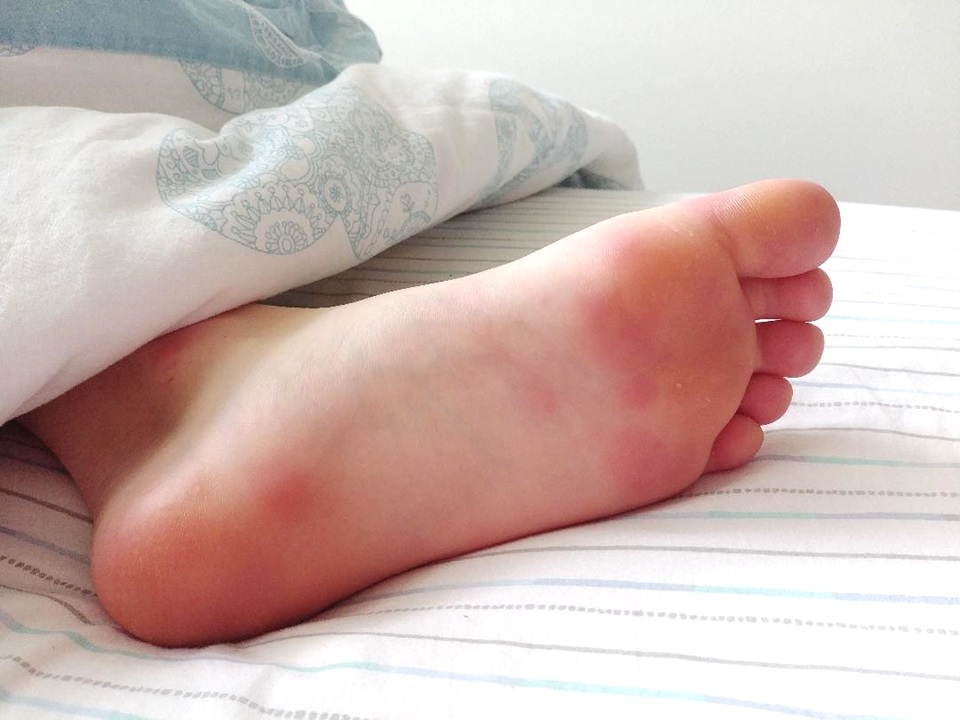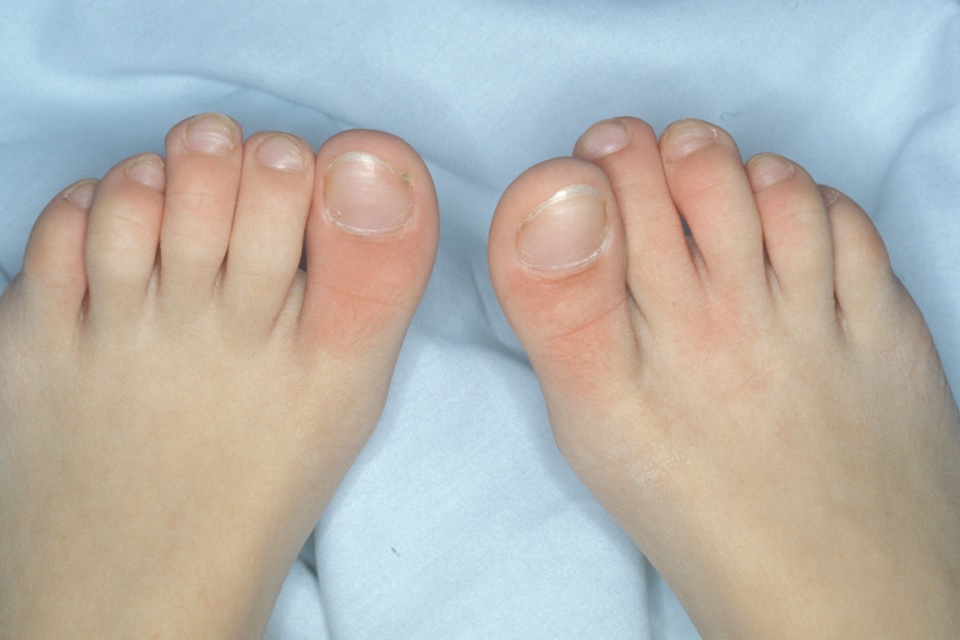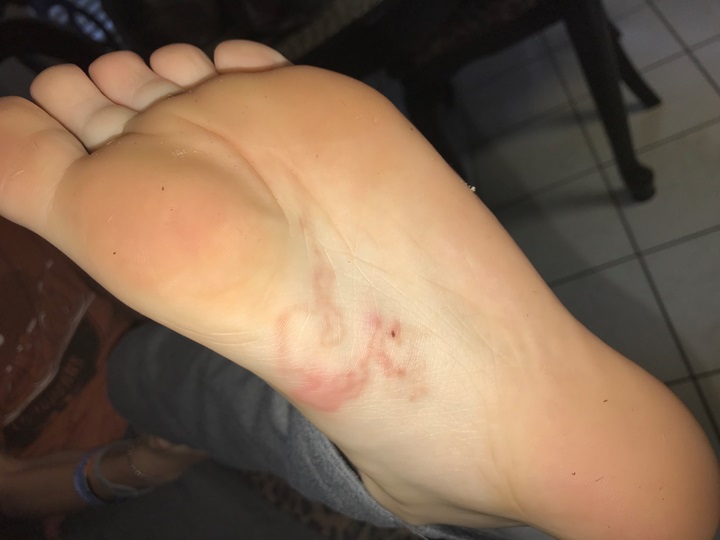Teen presents with foot pain, beginning with toes
Click Here to Manage Email Alerts
A previously healthy 15-year-old female presents for a virtual clinic visit for bilateral foot pain for the last 2 days. The pain began in her toes, then progressed to painful, erythematous nodules on her soles. She also reports having a fever of 38.2°C (100.8°F) the previous evening. She has no other complaints at this time and otherwise feels well. She denies any trauma; however, during the period of being quarantined with her family because of the COVID-19 pandemic, she has been engaging in hip hop dance classes in the family’s garage, as well as walking in the neighborhood for exercise, while using old shoes with poor support. She initially attributed the foot pain to muscle soreness from her activities.

Because this was a virtual appointment, no examination was done, but digital pictures of the soles of her feet were sent to the provider, as shown in Figure 1. At this time, she was diagnosed with soft tissue injury, caused by her exercise regimen, and treated symptomatically with ibuprofen, ice and rest. During the follow-up virtual visit the next day, she reported some malaise with ongoing foot pain (Figure 2) that somewhat worsened, but no more fever. Her mother reported that the family had recently obtained an inflatable hot tub, which the patient had been using. The water was reported as being somewhat “murky-appearing” recently.

What’s your diagnosis?
A. Pseudomonas hot-foot syndrome
B. Cutaneous larva migrans
C. COVID toes syndrome
D. Runner’s foot syndrome
Case discussion


The answer is A, pseudomonas hot-foot syndrome. This case illustrates several unique aspects of pediatric outpatient clinic operations during the COVID-19 pandemic. First, telehealth and virtual appointments have become highly utilized in accordance with the CDC and AAP recommendations. Our clinic continues to provide in-person well visits for young children and triaging sick visits via telehealth. This case was conducted over the phone using photographs. Also, this family was following the recommended quarantine guidelines. To alleviate the monotony of prolonged quarantine, our patient was practicing hip hop dance and going for long walks for exercise. She presented with foot pain that was initially thought to be due to soft tissue injury secondary to her home fitness activity. The recently purchased inflatable hot tub was likely not properly maintained. Finally, COVID-19 is now on the differential for a myriad of presenting chief complaints. This patient presented with fever and painful foot lesions. Although not the common presentation of SARS-CoV-2, “COVID toes” is documented as a possible feature of the disease and was considered by the clinician in this case.

The pseudomonas “hot-foot syndrome” was first described in 2001 in The New England Journal of Medicine, and subsequently in the Journal of the American Academy of Dermatology in 2007. This is a self-limiting condition related to exposure to contaminated water, usually in poorly maintained pools or hot tubs. It is thought to occur in children due to the thinner stratum corneum and presents 6 to 48 hours after exposure with painful erythematous nodules on the soles. It may be associated with fevers and malaise. Our patient had no further issues, and symptoms resolved without additional intervention.

COVID toes may resemble chilblains, or inflammation of small blood vessels typically caused by cold exposure and limited to the toes, which may look similar to Figure 3. This contrasts with our patient, who also presented with painful red nodules of the bilateral plantar forefoot. Additionally, our patient had no respiratory symptoms — only fever and malaise. This point is mentioned to show the progressive widening differential of COVID-19, especially in children.

The hookworm Ancylostoma braziliense is the cause of cutaneous larva migrans, and although common in the tropics, it is also found in the Southeastern United States. The foot is the most common site of involvement. There may be a small nodule at the point of entrance of the larva, but the track-like rash made by the worm is relatively painless (Figure 4).
Runner’s foot syndrome may apply to the common injuries associated with new runners and those who run marathons and other endurance events, including painful blisters, calluses and thickened nails, especially of the second toe, which may bump into the tip of the shoe while running, as well as various orthopedic injuries of the foot. None of this fit the patient presented.
Editor’s note: The views expressed in this article do not necessarily reflect the official policy or position of the Department of the Navy, Department of Defense, or the United States government.
Columnist comments: I want to thank Amy Michalski, MD, a staff pediatrician, and Lt. Scott Toney, MD, a pediatric resident, both at the Balboa Naval Medical Center in San Diego, for contributing this case.
Suggested reading:
Kolivras, A, et al. JAAD Case Rep. 2020;doi:10.1016/j.jdcr.2020.04.011.
Yu Y, et al. J Am Acad Dermatol. 2007;doi:10.1016/j.jaad.2007.04.004.
For more information:
James H. Brien, DO, is with the department of infectious diseases at McLane Children’s Hospital, Baylor Scott & White Health, and an adjunct professor of pediatrics at Texas A&M College of Medicine in Temple, Texas. He also is a member of the Infectious Diseases in Children Editorial Board. Brien can be reached at jhbrien@aol.com.
